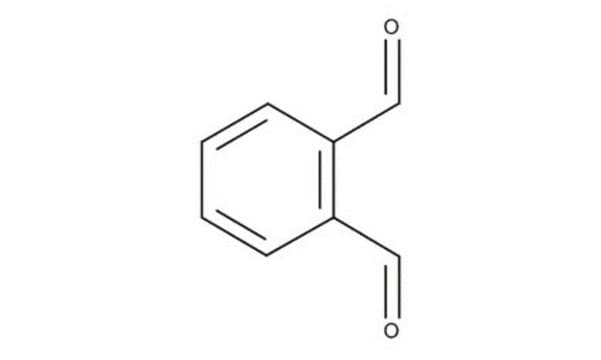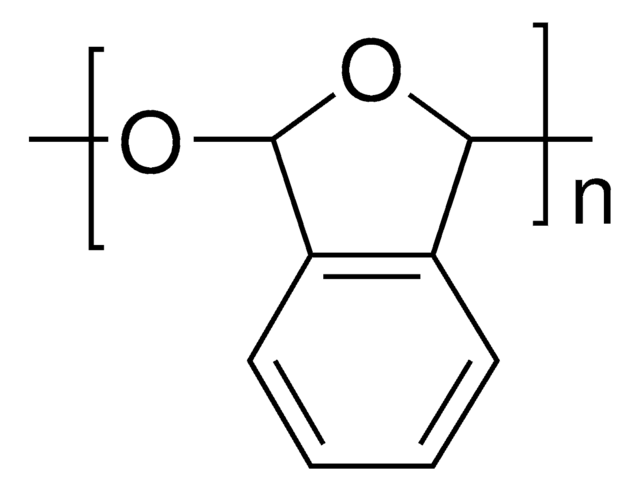If this product has an expiration or retest date, it will be shown on the Certificate of Analysis (COA, CofA). If there is no retest or expiration date listed on the product's COA, we do not have suitable stability data to determine a shelf life. For these products, the only date on the COA will be the release date; a retest, expiration, or use-by-date will not be displayed.
For all products, we recommend handling per defined conditions as printed in our product literature and website product descriptions. We recommend that products should be routinely inspected by customers to ensure they perform as expected.
For products without retest or expiration dates, our standard warranty of 1 year from the date of shipment is applicable.
For more information, please refer to the Product Dating Information document: https://www.sigmaaldrich.com/deepweb/assets/sigmaaldrich/marketing/global/documents/449/386/product-dating-information-mk.pdf
P1378
Ftaldialdehído
≥97% (HPLC), powder or crystals
Sinónimos:
Dicarboxaldehído o-ftálico, o-Ftalaldehído, Benceno-1,2-dicarboxaldehído, OPA
About This Item
Productos recomendados
Quality Level
assay
≥97% (HPLC)
form
powder or crystals
color
white to light yellow
mp
55-58 °C
storage temp.
2-8°C
SMILES string
O=Cc1ccccc1C=O
InChI
1S/C8H6O2/c9-5-7-3-1-2-4-8(7)6-10/h1-6H
InChI key
ZWLUXSQADUDCSB-UHFFFAOYSA-N
¿Está buscando productos similares? Visita Guía de comparación de productos
Application
- para detectar Arg a través de espectrofotometría utilizando detección sensible a la fluorescencia de punto final
- como una corriente reactiva con la muestra para dar lugar a un producto fluorescente destinado a determinar el amoníaco en el agua de mar
- en el análisis espectrofotométrico del o-ftaldialdehído (prueba OPA) para determinar la actividad proteolítica (PA) de las cepas y los cultivos comerciales
Biochem/physiol Actions
signalword
Danger
hcodes
Hazard Classifications
Acute Tox. 3 Oral - Aquatic Acute 1 - Aquatic Chronic 1 - Eye Dam. 1 - Skin Corr. 1B - Skin Sens. 1 - STOT SE 3
target_organs
Respiratory system
Storage Class
6.1A - Combustible acute toxic Cat. 1 and 2 / very toxic hazardous materials
wgk_germany
WGK 3
flash_point_f
269.6 °F - closed cup
flash_point_c
132 °C - closed cup
ppe
Faceshields, Gloves, Goggles, type ABEK (EN14387) respirator filter
Elija entre una de las versiones más recientes:
¿Ya tiene este producto?
Encuentre la documentación para los productos que ha comprado recientemente en la Biblioteca de documentos.
Los clientes también vieron
-
How can I determine the shelf life / expiration / retest date of this product?
1 answer-
Helpful?
-
-
How is shipping temperature determined? And how is it related to the product storage temperature?
1 answer-
Products may be shipped at a different temperature than the recommended long-term storage temperature. If the product quality is sensitive to short-term exposure to conditions other than the recommended long-term storage, it will be shipped on wet or dry-ice. If the product quality is NOT affected by short-term exposure to conditions other than the recommended long-term storage, it will be shipped at ambient temperature. As shipping routes are configured for minimum transit times, shipping at ambient temperature helps control shipping costs for our customers. For more information, please refer to the Storage and Transport Conditions document: https://www.sigmaaldrich.com/deepweb/assets/sigmaaldrich/marketing/global/documents/316/622/storage-transport-conditions-mk.pdf
Helpful?
-
-
Is Ortho phthaldehyde HPLC purity of >99% or >97% good enough for use an analytical grade reagent ?
1 answer-
This product has a minimum purity specification of 98%. For analytical purposes, high purity product options are generally preferred. Product P0657, Phthaldialdehyde, offers a minimum purity of 99% and is tested for suitability in fluorometric HPLC.
Please see the link below to review this product option:
https://www.sigmaaldrich.com/product/sial/p0657Helpful?
-
-
Has pthaldialdehyde been used to fix tissue and/or cells, and if so, what was the concentration?
1 answer-
The primary use of P1378 is for assaying amines or sulfhydryls in solution. It does not appear to be used as a fixative, although there are reports of its use as a high-level disinfectant. Phthalaldehyde is commonly used as a high-level disinfectant for medical instruments, typically sold under the brand names of Cidex OPA or TD-8. However, in the case of Phthalaldehyde, its use appears to be as a disinfectant rather than as a fixative. The product is tested for appearance, HPLC for purity, color, solubility, and for carbon content. No suitability testing is performed for any specific use.
Helpful?
-
Active Filters
Nuestro equipo de científicos tiene experiencia en todas las áreas de investigación: Ciencias de la vida, Ciencia de los materiales, Síntesis química, Cromatografía, Analítica y muchas otras.
Póngase en contacto con el Servicio técnico













